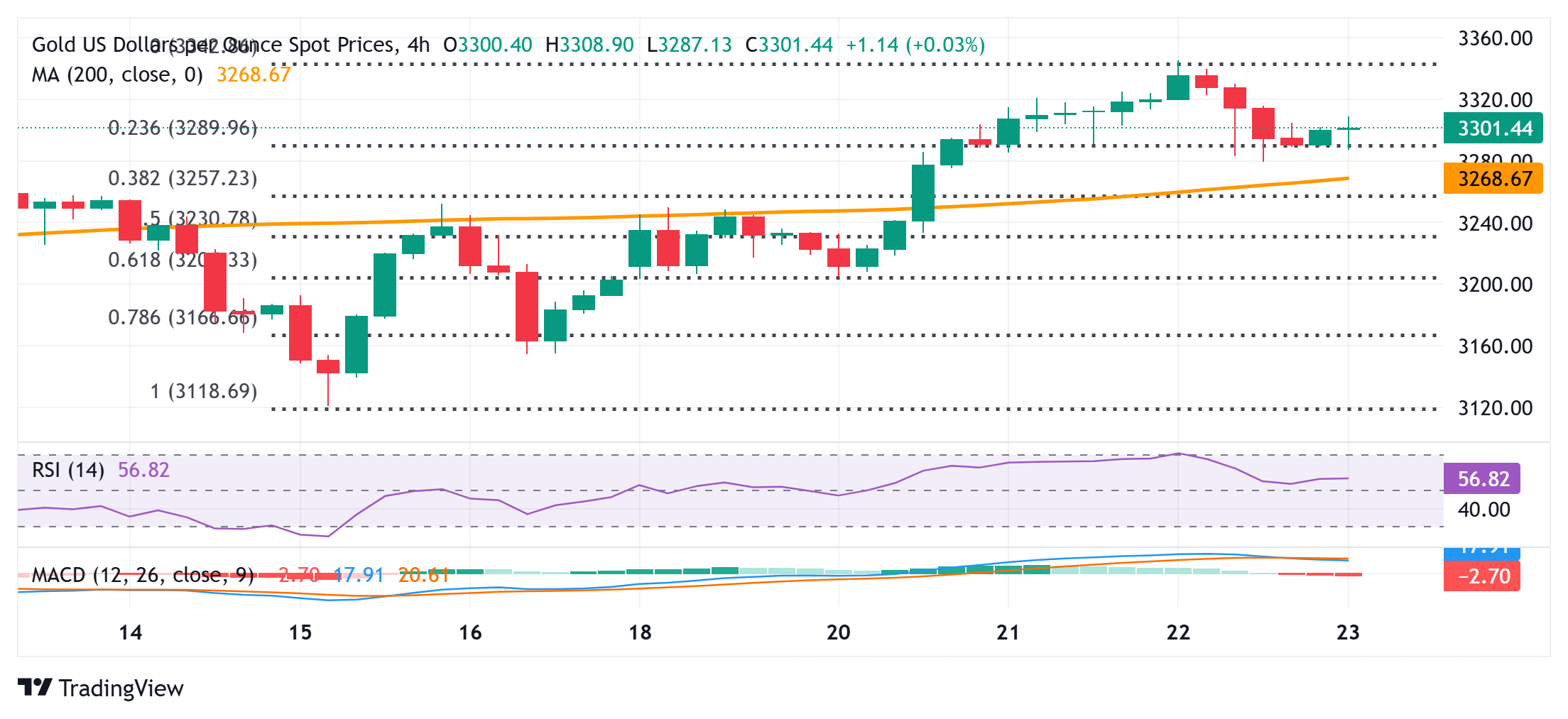- Gold price attracts fresh buyers on Friday and remains close to a two-week top set on Thursday.
- US fiscal concerns, US-China trade tensions, and geopolitical risks underpin the XAU/USD pair.
- Fed rate cut bets weigh on the USD and support prospects for further gains for the commodity.
Gold price (XAU/USD) regains positive traction following the previous day’s pullback from a two-week high and trades above the $3,300 mark during the Asian session on Friday. Worries about the worsening US fiscal situations, renewed US-China trade tensions, and persistent geopolitical risks turn out to be key factors that continue to act as a tailwind for the safe-haven bullion. Apart from this, the emergence of fresh US Dollar (USD) selling lends additional support to the commodity.
The initial market reaction to Thursday’s mostly upbeat US economic data turned out to be short-lived amid US fiscal concerns. Furthermore, the growing acceptance that the Federal Reserve (Fed) will lower borrowing costs at least twice this year weighs on the Greenback and drives flows toward the non-yielding yellow metal. Nevertheless, the XAU/USD remains on track to register its best weekly gain in more than a month and the fundamental backdrop favors bullish traders.
Daily Digest Market Movers: Gold price bulls retain control amid a combination of supporting factors
- The Republican-controlled US House of Representatives on Thursday narrowly passed President Donald Trump’s sweeping tax and spending bill. Trump’s dubbed “Big, Beautiful Bill”, which will add about $3.8 trillion to the federal government’s debt over the next decade, now heads to the Senate for approval.
- This comes on top of escalating US-China trade tensions, which have been fueling worries about the potential economic impact. Adding to this, the prospects for further policy easing by the Federal Reserve continue to undermine the US Dollar and assist the Gold price to stall the previous day’s retracement slide.
- On the economic data front, the US Department of Labor (DOL) reported on Thursday that the number of Americans filing for unemployment insurance fell to 227K last week. This pointed to a positive sign for the US labor market and the economy as a whole, which provided a modest lift to the US Dollar.
- Meanwhile, S&P Global’s flash estimate showed that the US economy saw a notable rebound in private sector activity in May and the Composite PMI rose to 52.1. Moreover, the US flash Manufacturing PMI increased to 52.3 in May – the highest in three months – and the Services PMI reached a two-month high of 52.3.
- Trump reportedly told European leaders that Russian President Vladimir Putin isn’t ready to end the war with Ukraine as he thinks he is winning. Adding to this, the killing of two Israeli diplomats in the US keeps geopolitical risks in play and should further offer support to the safe-haven precious metal.
- Traders now look forward to the release of New Home Sales data from the US, which, along with speeches by influential FOMC members will drive the USD demand. Apart from this, trade developments and the broader risk sentiment should provide some meaningful impetus to the XAU/USD pair.
Gold price seems poised to climb further beyond the overnight swing high and test $3,363-3,365 hurdle

From a technical perspective, the overnight retracement slide from a two-week top shows some resilience below the 23.6% Fibonacci retracement level of the recent move up from the monthly low touched last week. Moreover, positive oscillators on hourly/daily charts favor bullish traders and support prospects for an extension of over a one-week-old uptrend. Hence, any subsequent slide could be seen as a buying opportunity and find support near the $3,260-3,258 confluence – comprising the 38.2% Fibo. retracement level and the 200-period Simple Moving Average (SMA) on the 4-hour chart. A convincing break below, however, might prompt some technical selling and pave the way for deeper losses, towards the 50% retracement level around the $3,232 region, en route to the $3,200 round figure.
On the flip side, the $3,320-3,325 zone could act as an immediate hurdle ahead of the overnight swing high, around the $3,346 area. Some follow-through buying has the potential to lift the Gold price beyond the $3,363-3,365 intermediate hurdle and allow bulls to reclaim the $3,400 round figure. A sustained strength beyond the latter will reaffirm the near-term positive outlook and set the stage for a further appreciating move.
US-China Trade War FAQs
Generally speaking, a trade war is an economic conflict between two or more countries due to extreme protectionism on one end. It implies the creation of trade barriers, such as tariffs, which result in counter-barriers, escalating import costs, and hence the cost of living.
An economic conflict between the United States (US) and China began early in 2018, when President Donald Trump set trade barriers on China, claiming unfair commercial practices and intellectual property theft from the Asian giant. China took retaliatory action, imposing tariffs on multiple US goods, such as automobiles and soybeans. Tensions escalated until the two countries signed the US-China Phase One trade deal in January 2020. The agreement required structural reforms and other changes to China’s economic and trade regime and pretended to restore stability and trust between the two nations. However, the Coronavirus pandemic took the focus out of the conflict. Yet, it is worth mentioning that President Joe Biden, who took office after Trump, kept tariffs in place and even added some additional levies.
The return of Donald Trump to the White House as the 47th US President has sparked a fresh wave of tensions between the two countries. During the 2024 election campaign, Trump pledged to impose 60% tariffs on China once he returned to office, which he did on January 20, 2025. With Trump back, the US-China trade war is meant to resume where it was left, with tit-for-tat policies affecting the global economic landscape amid disruptions in global supply chains, resulting in a reduction in spending, particularly investment, and directly feeding into the Consumer Price Index inflation.




